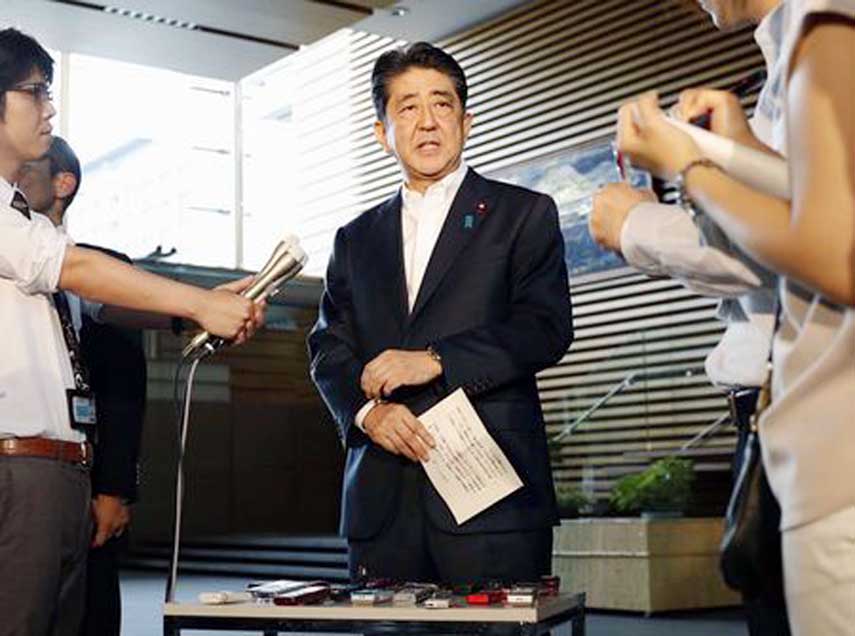
AFP, Tokyo :
Japanese Prime Minister Shinzo Abe said Tuesday that he and US President Donald Trump agreed to hike pressure on North Korea after it launched a ballistic missile over Japan, in Pyongyang’s most serious provocation in years.
“We must immediately hold an emergency meeting at the United Nations, and further strengthen pressure against North Korea,” Abe told reporters after a 40-minute phone call with Trump.
“Increasing pressure-Japan and the United States are in complete agreement about this,” Abe added, without elaborating on proposed measures.
He added that Trump-who has been embroiled in an escalating war of words with Pyongyang over its weapons development-said Washington would stand by its ally Japan.
“President Trump made a very strong commitment that the United States is with Japan 100 percent,” Abe quoted Trump as saying.
“We will cooperate among Japan, the US and South Korea. We will also reach out to China, Russia and the international community and apply strong pressure on North Korea to change their policy.”
Last week, Japan said it would impose fresh sanctions on North Korea by freezing the assets of Chinese and Namibian firms doing business with the nuclear-armed state.
The move against a half dozen organisations and a couple of individuals comes days after Washington expanded its own punitive measures against Chinese and Russian firms, as well as people linked to Pyongyang over its weapons development.
The sanctions are aimed at disrupting the flow of cash funding North Korean weapons programmes, which are in violation of United Nations resolutions.
The U.S. disarmament ambassador said Washington still needed to do “further analysis” of the launch, but it will be the subject of a U.N. Security Council meeting later in the day.
“It’s another provocation by North Korea, they just seem to continue to happen,” U.S. envoy Robert Wood told reporters in Geneva.
“This is a big concern of course to my government and to a number of other governments,” Wood said before a session of the U.N.-sponsored Conference on Disarmament.
North Korean Ambassador Han Tae Song told the session the United States was driving the Korean peninsula “towards and extreme level of explosion” by deploying strategic assets and conducting nuclear war drills.
In China, North Korea’s lone major ally, Foreign Ministry spokeswoman Hua Chunying said the crisis was “approaching a critical juncture”, but it was also maybe a turning point to open the door to peace talks.
A Japan Self-Defense Forces (JSDF) soldier takes part in a drill to mobilise their Patriot Advanced Capability-3 (PAC-3) missile unit in response to a recent missile launch by North Korea, at U.S. Air Force Yokota Air Base in Fussa on the outskirts of Tokyo, Japan August 29, 2017. REUTERS/Issei Kato
South Korea’s military said the missile was launched from near the North Korean capital, Pyongyang, just before 6 a.m. (2100 GMT Monday) and flew 2,700 km (1,680 miles), reaching an altitude of about 550 km (340 miles).
Four South Korean fighter jets bombed a military firing range on Tuesday after President Moon Jae-in asked the military to demonstrate capabilities to counter North Korea.
South Korea and the United States had discussed deploying additional “strategic assets” on the Korean peninsula, the presidential Blue House said in a statement, without giving more details.
North Korea remained defiant.
“The U.S. should know that it can neither browbeat the DPRK with any economic sanctions and military threats and blackmail nor make the DPRK flinch from the road chosen by itself,” North Korea’s official Rodong Sinmun said, using the initials of the North’s official name, the Democratic People’s Republic of Korea.
Global markets reacted to the escalation in tension, buying safe-haven assets such as gold, the Swiss franc and even the Japanese yen on expectation domestic investors would bring large amounts of currency home in times of uncertainty.
Some experts said the test appeared to have been of a recently developed intermediate-range Hwasong-12 missile, but there was no clear consensus.
This month, North Korea threatened to fire four missiles into the sea near the U.S. Pacific territory of Guam after Trump said it would face “fire and fury” if it threatened the United States.
“Alas, Pyongyang has demonstrated that its threats to the U.S. base on Guam are not a bluff,” Konstantin Kosachev, chairman of Russia’s upper house of parliament’s international affairs committee, said on social media.
North Korea fired what it said was a rocket carrying a communications satellite into orbit over Japan in 2009 after warning of its plan. The United States, Japan and South Korea considered it a ballistic missile test.
Japanese Chief Cabinet Secretary Yoshihide Suga said the latest missile fell into the sea 1,180 km (735 miles) east of Cape Erimo on Hokkaido.
Television and radio broadcasters broke into their regular programming with a “J-Alert” warning citizens of the missile launch. Bullet train services were temporarily halted and warnings went out over loudspeakers in towns in Hokkaido.
“I was woken by the missile alert on my cellphone,” said Ayaka Nishijima, 41, an office worker on Honshu island.
“I didn’t feel prepared at all. Even if we get these alerts there’s nowhere to run. It’s not like we have a basement or bomb shelter, all we can do is get away from the window,” she told Reuters by text message.
This month, the 15-member U.N. Security Council unanimously imposed new sanctions on North Korea in response to two long-range missile launches in July.

